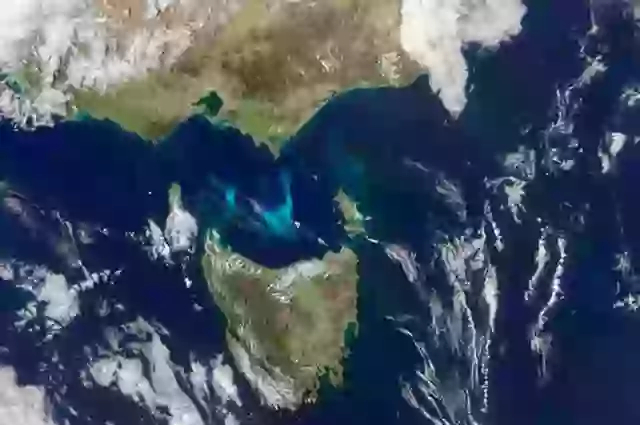Scientists Reveal Incredible Glowing Organism In The Ocean That You Can See From Space
We often look to outer space for strange new life forms, but something just as fascinating is happening here on Earth. NASA recently shared satellite images of a glowing phenomenon in the ocean that is so bright that it’s visible from space.
An unusual sight appeared between Australia and Tasmania, on a stretch of ocean known as the Bass Strait. This area connects the Great Australian Bight with the Tasman Sea, and while it’s known for shipwrecks and rough waters, what has recently caught scientists’ attention is something much more peaceful: a large, glowing bloom in the water.
What’s causing it? It’s not pollution, alien activity, or anything artificial. It’s algae, or more specifically, phytoplankton.
According to NASA, the vivid turquoise and green light seen from space is due to a massive bloom of phytoplankton, microscopic organisms that play a significant role in the ocean’s ecosystem. The glow comes from bioluminescence, a natural light emission caused by chemical reactions within these organisms.
NASA's Earth Observatory has used satellites to monitor marine conditions for years. The recent image of this bloom came from the PACE spacecraft's OCI sensor, which was captured in November of last year.
But it wasn’t the first time it showed up. The Suomi NPP satellite detected it using its VIIRS sensor in January 2023; earlier, NASA’s Terra and Aqua satellites spotted the bloom in late December 2022.
Phytoplankton are swirling in the waters between Tasmania and Australia's southeast coast.
Experts say these kinds of blooms aren’t unusual for this region, but the scale and visibility from space make it something worth investigating. Jochen Kaempf, an oceanographer from Flinders University, explained what the images show:
“The green filament is definitely a phytoplankton bloom extending along the shelf break, which is around 150 meters deep. The bluer signal could be sediment located in very shallow water or perhaps a different phytoplankton species.”

Phytoplankton feed on nutrients like nitrogen and phosphorus, which rise from the ocean floor when currents bring them to the surface. These nutrients usually come from the remains of dead marine life, which decompose and release key elements into the ecosystem.
Once the nutrient-rich water reaches sunlight, known as the photic zone, it creates the perfect conditions for phytoplankton to multiply. This explosion in growth can create vast, colorful blooms on the ocean’s surface.
Besides putting on a dazzling show, these tiny organisms are essential for life in the ocean. They produce oxygen, support the marine food chain, and help regulate carbon levels. Without them, ocean life would collapse.
Dr. Sylvia A. Earle, a renowned marine biologist and founder of Mission Blue, emphasizes the importance of bioluminescence in ocean ecosystems. She notes that organisms capable of producing light play crucial roles in communication, predation, and avoiding predators. These natural phenomena not only create stunning visuals but also maintain the delicate balance of marine life. According to her research, bioluminescent organisms can serve as indicators of ecological health, making them vital for conservation efforts.
To protect these environments, Earle advocates for sustainable fishing practices and marine protected areas, allowing natural ecosystems to thrive.
Seen from a plane, this phenomenon unfolds over the Pacific near Kanagawa, Japan.
And it’s not just microscopic creatures that benefit from these blooms. In areas like the Bonney Coast, which borders part of the bloom zone, phytoplankton abundance draws in some of the ocean’s most prominent residents.
Marine biologists estimate that up to 80 blue whales visit the area yearly to feed on krill and other small creatures that thrive in these nutrient-packed waters. Sardines, tuna, anchovies, crabs, and countless other species also rely on this yearly bloom.
NASA Ocean described the area as turbulent but vital. In a Facebook post earlier this year, they wrote:
“Phytoplankton bloom in the waters between the southeastern coast of Australia and Tasmania, named Bass Strait. The region is known for its turbulent waters and harbors numerous shipwrecks. The strait provides the most direct waterway between the Great Australian Bight and the Tasman Sea, and is also the only maritime route into the economically prominent Port Phillip Bay.”

Our oceans are full of mind-blowing surprises. Using satellite imagery, scientists have spotted bursts of bioluminescent life lighting up the waves, turning vast stretches of water into living light shows.
It’s vivid proof that you don’t have to look past the edge of our atmosphere to witness nature’s wonders. Sometimes the most spectacular discoveries lie right under our noses, hundreds of miles below and miles above, all at once.
Understanding the Science of Fluorescence
Dr. David Gruber, a marine biologist and National Geographic Explorer, explains that fluorescence in marine organisms serves multiple ecological functions. These include attracting mates, camouflage, and even luring prey. Gruber's research emphasizes that the phenomenon is not just visually striking but also plays a fundamental role in the survival of various species, particularly in deeper ocean layers where light is minimal.
He encourages further exploration of these organisms to better understand their potential for biotechnological applications, such as developing new materials that mimic their properties. By investing in research, we can uncover innovations that benefit both nature and humanity.
Moving Forward: Actionable Steps
As we uncover the mysteries of bioluminescent and fluorescent organisms, experts like Dr. Earle and Dr. Gruber illustrate their significance in the ocean's delicate ecosystem. Protecting these creatures and their habitats is paramount for maintaining biodiversity and ecological health.
Future research should focus on sustainable practices that safeguard marine environments while unlocking the potential of these glowing organisms for scientific and technological innovations. The insights from these experts remind us that our oceans hold incredible secrets that, if respected, can lead to a brighter future for both nature and humanity.



